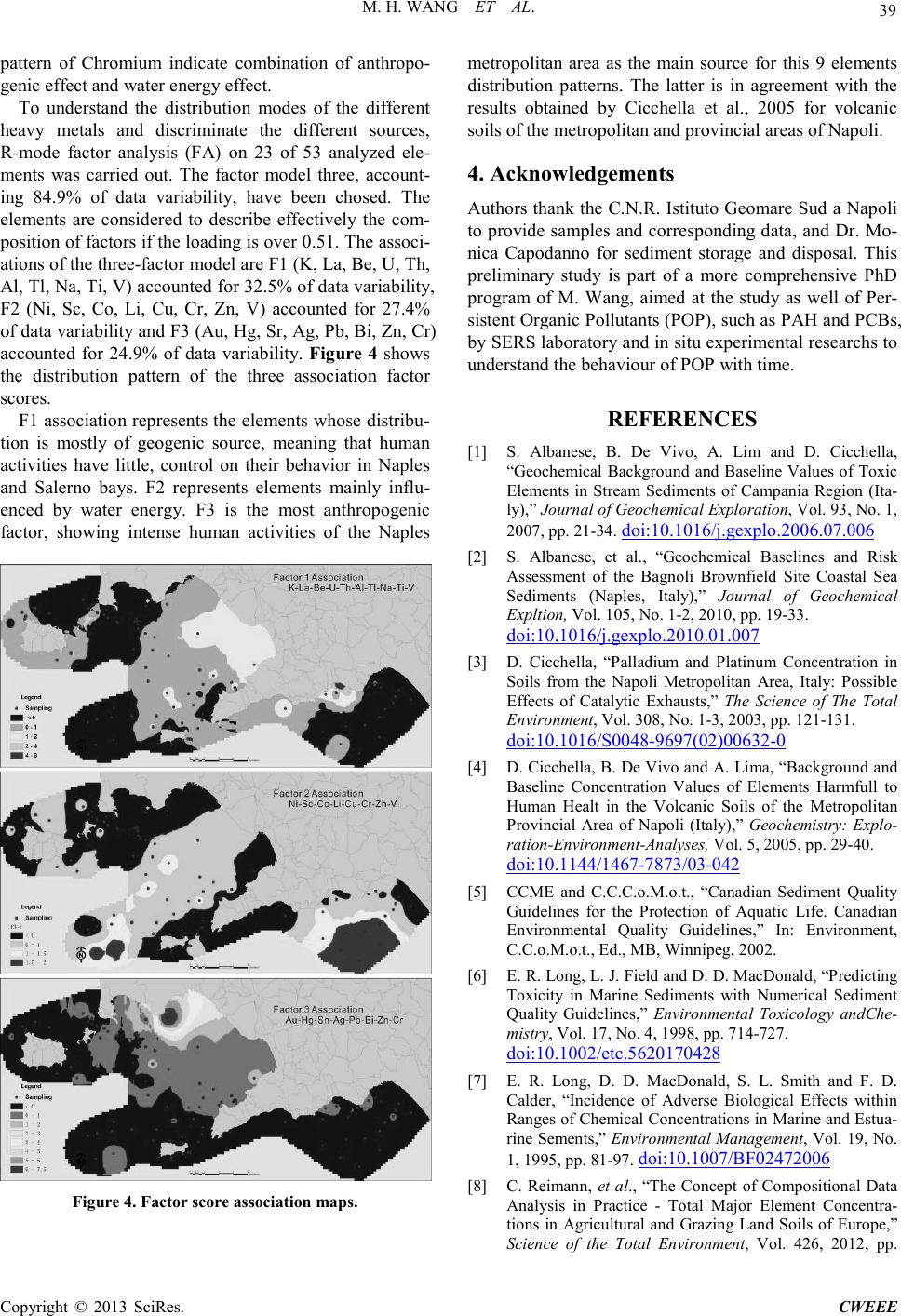
M. H. WANG ET AL.
Copyright © 2013 SciRes. CWEEE
pattern of Chromium indicate combination of anthropo-
genic effect and water energy effect.
To understand the distribution modes of the different
heavy metals and discriminate the different sources,
R-mode factor analysis (FA) on 23 of 53 analyzed ele-
ments was carried out. The factor model three, account-
ing 84.9% of data variability, have been chosed. The
elements are considered to describe effectively the com-
position of factors if the loading is over 0.51. The associ-
ations of the three-factor model are F1 (K, La, Be, U, Th,
Al, Tl, Na, Ti, V) accounted for 32.5% of data variability,
F2 (Ni, Sc, Co, Li, Cu, Cr, Zn, V) accounted for 27.4%
of data variability and F3 (Au, Hg, Sr, Ag, Pb, Bi, Zn, Cr)
accounted for 24.9% of data variability. Figure 4 shows
the distribution pattern of the three association factor
score s.
F1 association represents the elements whose distribu-
tion is mostly of geogenic source, meaning that human
activities have little, control on their beha vio r in Naples
and Salerno bays. F2 represents elements mainly influ-
enced by water energy. F3 is the most anthropogenic
factor, showing intense human activities of the Naples
Figure 4. Factor score association maps.
metropolitan area as the main source for this 9 elements
distribution patterns. The latter is in agreement with the
results obtained by Cicchella et al., 2005 for volcanic
soils of the metropolitan and provincial areas of Napoli.
4. Acknowledgements
Authors thank the C.N. R. Istituto Geomare Sud a Napoli
to provide samples and corresponding data, and Dr. Mo-
nica Capodanno for sediment storage and disposal. This
preliminary study is part of a more comprehensive PhD
program of M. Wang, aimed at the study as well of Per-
sistent Organic Pollutants (POP), such as PAH and PCBs,
by SERS laboratory and in situ experimental researchs to
understand the behaviour of POP with time.
REFERENCES
[1] S. Albanese, B. De Vivo, A. Li m and D. Cicchella,
“Geochemical Background and Baseline Values of Toxic
Elements in Stream Sediments of Campania Region (Ita-
ly),” Journal of Geochemical Exploration, Vol. 93, No. 1,
2007, pp. 21-34. doi:10.1016/j.gexplo.2006.07.006
[2] S. Albanese, et al., “Geochemical Baselines and Risk
Assessment of the Bagnoli Brownfield Site Coastal Sea
Sediments (Naples, Italy),” Journal of Geochemical
Expltion, Vol. 105, No. 1-2, 2010, pp. 19-33.
doi:10.1016/j.gexplo.2010.01.007
[3] D. Ci cchella, “Palladium and Platinum Concentration in
Soils from the Napoli Metropolitan Area, Italy: Possible
Effects of Catalytic Exhausts,” The Science of The Total
Environment, Vol. 308, No. 1-3, 2003, pp. 121-131.
doi:10.1016/S0048-9697(02)00632-0
[4] D. Cicch ella, B. De Vivo and A. Lima, “Background and
Baseline Concentration Values of Elements Harmfull to
Human Healt in the Volcanic Soils of the Metropolitan
Provincial Area of Napoli (Italy),” Geochemistry: Explo-
ration-Environment-Analyses, Vol. 5, 2005, pp. 29-40.
doi:10.1144/1467-7873/03-042
[5] CCME and C.C.C.o.M.o.t., “Canadian Sediment Quality
Guidelines for the Protection of Aquatic Life. Canadian
Environmental Quality Guidelines,” In: Environment,
C.C.o.M.o.t., Ed., MB, Winnipeg, 2002.
[6] E. R. Long, L. J. Field and D. D. MacDonald, “Predicting
Toxicity in Marine Sediments with Numerical Sediment
Quality Guidelines,” Environmental Toxicology andChe-
mistry, Vol. 17, No. 4, 1998, pp. 714-727.
doi:10.1002/etc.5620170428
[7] E. R. Long, D. D. MacDonald, S. L. Smith and F. D.
Calder, “Incidence of Adverse Biological Effects within
Ranges of Chemical Concentrations in Marine and Estua-
rine Seme nts,” Environmental Management, Vol. 19, No.
1, 1995, pp. 81-97. doi:10.1007/BF02472006
[8] C. Reimann, et al., “The Concept of Compositional Data
Analysis in Practice - Total Major Element Concentra-
tions in Agricultural and Grazing Land Soils of Europe,”
Science of the Total Environment, Vol. 426, 2012, pp.